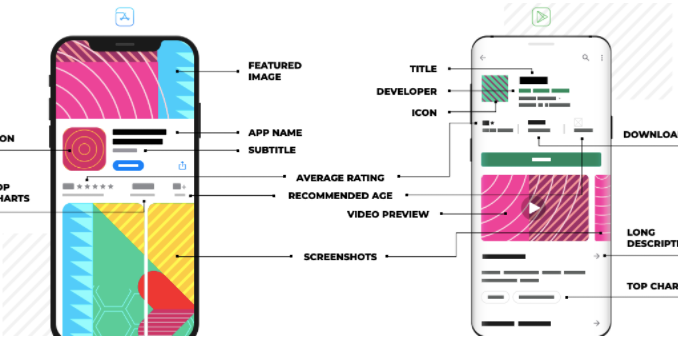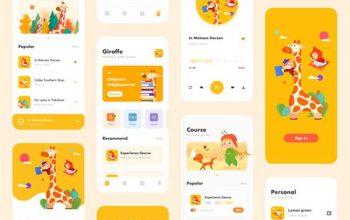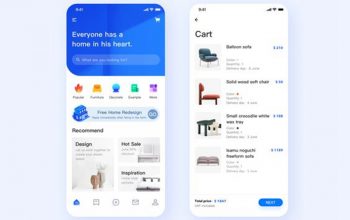ASO on-metadata are completely different with regards to optimizing an inventory in App Retailer and in Google Play in 2021 to get the utmost visibility and to enhance the conversion fee to obtain. The ASO begins (and ends) with the listings and it’s extremely essential that they’re 10/10 optimized.
However earlier than… let’s begin with the fundamentals:
- Table of Contents
- ASO on-metadata factors: Apple App Store vs. Google Play Store
- aso app store vs google play
- google play description
- ios 15 app store optimization
ASO definition (by ASO World)
ASO is the acronym of “App Retailer Optimization” and defines the optimization means of an app (each of its itemizing and of the app itself) with the purpose to extend its Search and Browse / Discover visibility on the app shops, in addition to to enhance its conversion fee to go to and to obtain. Briefly, ASO’s essential goal is to get extra downloads on the lowest value attainable.
ASO is the bottom of any App Advertising and marketing technique as, in addition to from offering natural downloads, it additionally has a direct influence on paid person acquisition campaigns prices and, thus, on enterprise. The higher the ASO, the upper the conversion fee to obtain and the decrease the CPI / CPL / CPA.
The commonest error in ASO just isn’t figuring out it, and the second is to suppose ASO is similar on the App Retailer and on Google Play. Even when all of the app shops have a really comparable foundation, there are some essential variations. Carry on studying to study all the ASO on-metadata variations between the 2 most essential app shops in the marketplace: Apple App Retailer (iOS) and Google Play Retailer (Android).
ASO on-metadata elements: Apple App Retailer vs. Google Play Retailer (2021)
The ASO elements are the texts and visuals of the shop itemizing of a cell app or recreation that may be instantly modified on App Retailer Join or Google Play Console. You could find all of them under:
Title / App Identify
Google Play: In Google Play’s case there are at present 50 characters accessible for the Title area, an important ASO on-metadata area, the place we must always embody probably the most related key phrases for the undertaking and those for which we wish to rank the very best. Additionally, the title must be descriptive and catchy. Quickly, Google Play plans to replace its tips and this area can be restricted to 30 characters.
App Retailer: In App Retailer’s case, the App Identify area accommodates 30 characters and, as for Google Play, you must add probably the most related key phrases on this area and those you need your app to rank for.
Quick description / Subtitle
Google Play: On Google Play there are 80 characters accessible that ought to embody the principle key phrases of the undertaking (you may even repeat some key phrases from the title to offer them extra relevance) and describe briefly the principle functionalities of the app. This article will be seen on the first sight of the person within the itemizing and thus have a direct influence on its resolution to put in the app or not.
App Retailer: On the App Retailer the subtitle area accommodates 30 characters that ought to embody the principle key phrases of the undertaking and describe briefly the principle functionalities of the app. This area seems proper under the App Identify, which implies that they need to be complementary and they need to not repeat the identical key phrases.
Promotional Textual content
Google Play: On Google Play there isn’t a such area, however the brief description has the same performance.
App Retailer: the promo textual content area accommodates 170 accessible characters and it’s the solely area on the App Retailer that may be up to date without having to publish a brand new model of the product. Apple recommends utilizing this area to “share the newest information concerning the app, corresponding to restricted gross sales or new functionalities”.
Full description
Google Play: The Description area on Google Play accommodates house for 4.000. The outline have to be used accurately to take advantage of out of its potential with regards to rank your cell app or recreation. You should watch out with “over-optimization”: the abuse of key phrases within the description is usually a purpose for Google Play’s rejection or, within the worst case, app suspension.
App Retailer: In Apple’s case, the outline just isn’t taken under consideration with regards to search outcomes. Nonetheless, the sector must be used as a advertising and marketing software to promote the app and its essential options, benefits, and so on.
Key phrases
Google Play: On Google Play there isn’t a key phrases area. Google tracks the Title, the Quick Description and the Lengthy Description (in addition to the developer identify and different fields) to know that are key phrases or theme / matter of an app or recreation.
App Retailer: On the App Retailer, there are 100 accessible characters to incorporate key phrases for the app. We remind you that you shouldn’t repeat key phrases that already are within the App Identify or Subtitle area and to separate key phrases solely with a comma, with none house (corresponding to “keyword1,keyword2,keywords3”, and so on.). Apple’s tips specify that utilizing opponents’ model key phrases may be an expulsion purpose, even when it’s a actually frequent observe within the sector…
Class
Google Play: Google divides apps in two huge teams: “apps” and “video games” which are additionally divided into completely different classes. It’s essential to be sure to select the appropriate possibility.
App Retailer: Apple permits to incorporate a major class and a secondary one in case the app suits into 2 classes, however the major class at all times must be thought of as an important one.
Tags
Google Play: On Google Play you may select as much as 5 taga that may assist Google perceive higher what the app or recreation is about. This choice is finished amongst a listing of current tags, which implies that you can not invent tags.
App Retailer: Tags don’t exist on the App Retailer. For now…
Icon
App Retailer and Google Play: The icon wants to obviously and creatively outline the principle performance(ies) of the app. We advocate you to make use of the identical icon on all of the app shops to bolster branding. Additionally, the icon on Google Play Retailer has a direct influence on natural site visitors, because it impacts the CTR, on search rating and on browse visibility (comparable app).
Screenshots
Google Play: You possibly can add as much as 8 screenshots.
App Retailer: You possibly can add as much as 10 screenshots.
In each shops, the screenshots instantly influence the CTR and the CVR (conversion fee to obtain), particularly the primary ones which are displayed.
Design screenshots that may allow you to generate downloads. Extra data right here.
Video
Google Play: Google Play affords the likelihood to publish a video accessible on YouTube within the app itemizing. This video may be descriptive or promotional.
App Retailer: In App Retailer’s case, you may add as much as 3 movies, although they will solely present app content material and be 100% useful. Promotional movies are usually not allowed.
Developer Identify
Google Play: On Google Play you may edit and customise the Developer Identify that seems publicly on the listings. With a 50 characters restrict, we advocate you to make use of key phrases to enhance their rating. Be VERY cautious with the adjustments you make on this area:
App Retailer: On the App Retailer the Developer Identify can’t be edited, however we nonetheless advocate including some key phrases there. To take action, the identify of your organization (or your identify as a bodily particular person) might want to include key phrases… and this isn’t so traditional.
Package deal Identify / Bundle ID
Google Play: On Google Play you may edit the app ID (URL) earlier than launching the app, and the key phrases which are within the area can be listed by Google and can assist us with the ASO key phrases rankings. Vital: as soon as the app is launched, this area can’t be up to date.
App Retailer: The app ID can’t be edited and doesn’t have any impact on key phrases rating.
ASO On-Metadata iOS vs. Android Scheme
| ASO on-metadata issue | Google Play Retailer | Apple App Retailer |
|---|---|---|
| Title – App Identify | 50 characters. Impacts on visibility and conversion. | 30 characters. Impacts on visibility and conversion. |
| Quick Description – Subtitle | 80 characters. Impacts on visibility and conversion. | 30 characters. Impacts on visibility and conversion. |
| Promotional textual content | Does not exist. | 180 characters. Doesn’t influence on visibility however does on conversion. |
| Description | 4.000 characters. Impacts on visibility and conversion. | 4.000 characters. Doesn’t influence on visibility however does on conversion. |
| Key phrases area | Does not existe. | 100 characters. |
| Icon | Impacts on visibility and conversion. | Impacts on conversion. |
| Screenshots | 8 screenshots. | 10 screenshots. |
| Featured picture | Impacts on conversion and is just confirmed if there’s a video. | Does not exist. |
| Video | 1 video. | 3 movies. |
| Class | 1 class. | 2 classes. |
| Tags | 5 tags. | Does not exist. |
| Developer Identify | May be edited. Impacts on visibility and conversion. | Cannot be edited. |
| Package deal Identify / Bundle ID | May be edited. Impacts on visibility and conversion. | Cannot be edited. |
ASO on-metadata App Retailer vs. Google Play in 2021 – Conclusions
These are the variations by way of ASO on-metadata elements in 2021 between the two essential app shops within the west: Apple App Retailer & Google Play Retailer.
Be at liberty to share the ASO on-metadata variations between iOS & Android with your pals and contacts on social media. Thanks!




